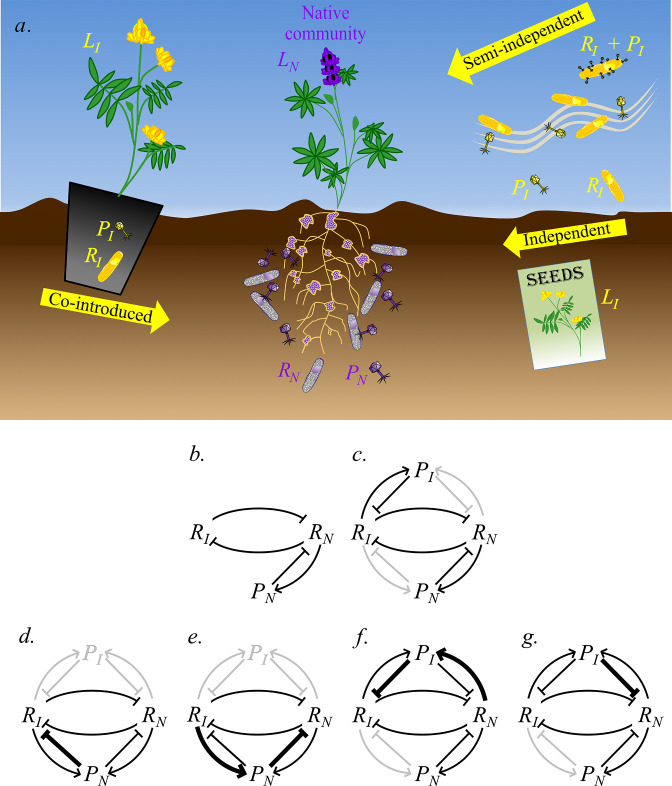FIG 1.
(a) This cartoon depicts different paths along which an invaded community might assemble. In the center, the native community, depicted in cool colors, includes the native legume (LN ), nodulated by its native rhizobium symbiont (RN ), which also lives free in the soil and hosts native phage (PN ). Biological entities from a hypothetical distant home range community, depicted in warm colors, can arrive via several pathways. On the left, a potted legume (LI ) is co-introduced with rhizobium (RI ) and phage (PI ) from its home range. On the lower right, the introduced legume (LI ) arrives as seed, with neither symbiont nor phage. On the top right, rhizobium from the distant home range is co-introduced with phage (RI + PI ). Alternatively, in the center right, phage (PI ) and/or rhizobium (RI ) arrive independently. (b–g) When introduced rhizobia (RI ) and native rhizobia (RN ) compete, the various ways they might interact with phages lead to different invasion biology hypotheses, as described below. (b) Introduced rhizobia (RI ) arrive without their familiar home range phages (PI ), are not infected by native phages (PN ), and compete with native rhizobia (RN ) (“enemy escape”). (c) Both rhizobia and phages are introduced from the same distant population. If each rhizobium is preyed upon only by its familiar phage (gray lines absent), then each rhizobium might be regulated by its familiar phage; however, the relative magnitudes of the dark lines determine if invasion can occur. If either rhizobium is attacked by an unfamiliar phage, the gray lines between that pair are present (dark). Again, several outcomes are possible, as described below. (d) Native phages affect introduced rhizobia more negatively than native rhizobia (“biotic resistance” via “reverse spillover”). (e) Native phages are strongly amplified by introduced rhizobia but more negatively affect native rhizobia (“enemy spillback”). (f) Introduced phages are strongly amplified by native rhizobia but more negatively affect introduced rhizobia (biotic resistance via “subsidized pathogen”). (g) Introduced phages more negatively affect native rhizobia than introduced rhizobia (“enemy spillover”). Note that panels d and e can occur, regardless of the presence of introduced phages, and that panels f and g can occur, regardless of whether native phages can attack introduced rhizobia. Lines indicate the direction of the interaction effect. Arrowheads indicate interactions that increase fitness of the biological entity at which the arrowheads point, while a flathead indicates interactions that decrease fitness of the receiving partner. Interactions and partners depicted in gray might be either present or absent, as described above. Arrow thickness indicates the magnitude of the interaction effect.

